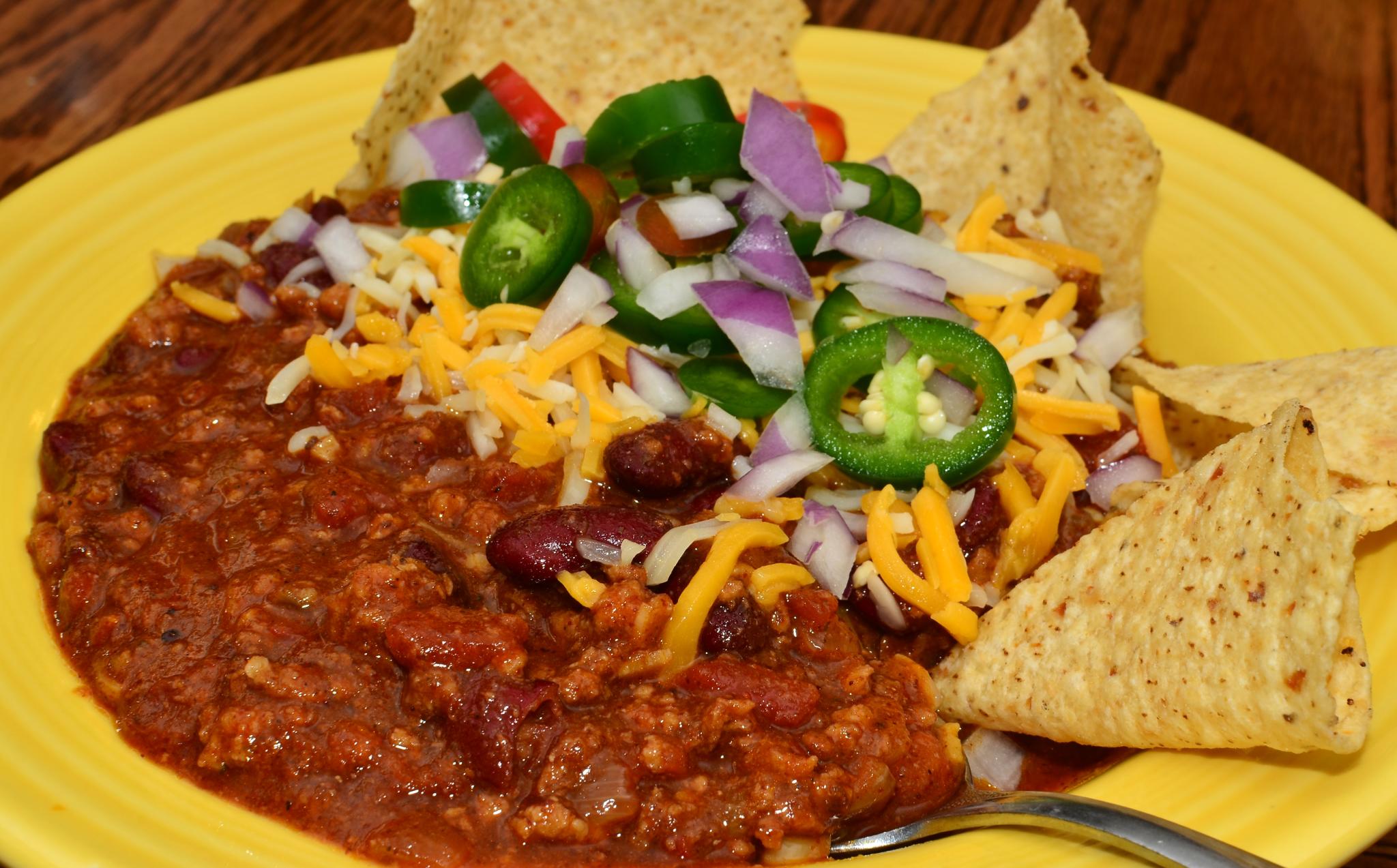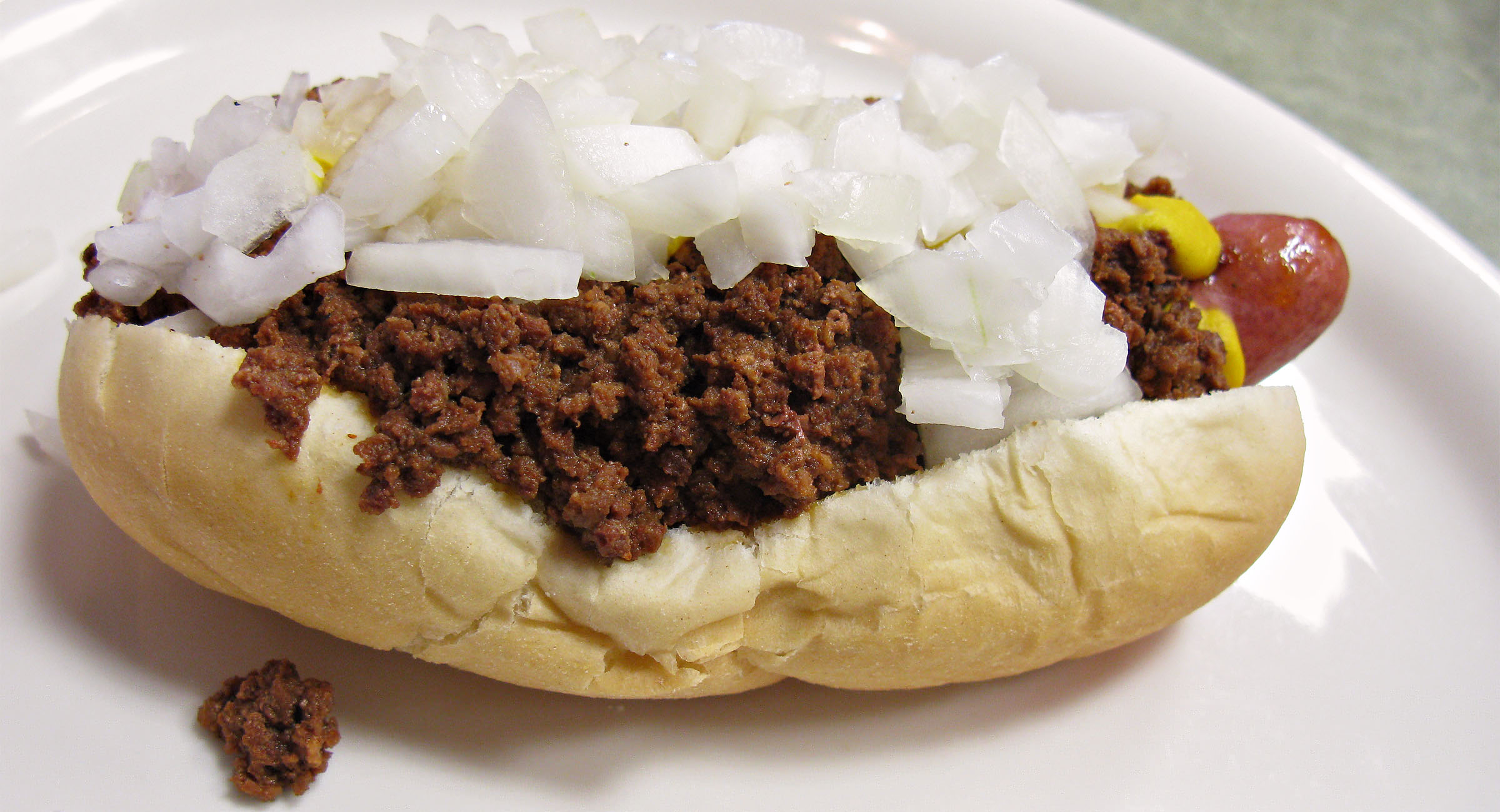|
Frank 'n Stuff
Frank 'n Stuff was the brand name of a hot dog stuffed with either cheese or chili and sold in the United States from mid-1986 until the 1990s by Hormel, as a variation of the chili dog. Frank 'n Stuff used Hormel brand chili for the filling and was one of the company's six major product introductions between 1986 and 1987. At the time, the company described the product as "the fun food that features a tunnel of cheese or chili inside a Hormel hot dog". Frank 'n Stuff's eponymous mascot was a friendly Frankenstein-type character and Hormel ran frequent television and print advertisements featuring him. In 1986, during labor unrest at a production plant, razor blades were found in two packages of the product, but there was no recall. See also * List of stuffed dishes This is a list of stuffed dishes, comprising dishes and foods that are prepared with various fillings and stuffings. Some dishes are not actually stuffed; the added ingredients are simply spread atop the base ... [...More Info...] [...Related Items...] OR: [Wikipedia] [Google] [Baidu] |
Hot Dog
A hot dog (uncommonly spelled hotdog) is a food consisting of a grilled or steamed sausage served in the slit of a partially sliced Hot dog bun, bun. The term hot dog can refer to the sausage itself. The sausage used is a wiener (Vienna sausage) or a frankfurter (Frankfurter Würstchen, also just called frank). The names of these sausages commonly refer to their assembled dish. Some consider a hot dog to technically be a sandwich. Hot dog preparation and condiments vary worldwide. Typical condiments include mustard, ketchup, relish, onions in tomato sauce, and cheese sauce. Common garnishes include sauerkraut, diced onions, jalapeños, chili, grated cheese, coleslaw, bacon, and olives. Hot dog variations, Hot dog variants include the corn dog and pigs in a blanket. The hot dog's cultural traditions include the Nathan's Hot Dog Eating Contest and the Wienermobile, Oscar Mayer Wienermobile. These types of sausages were culturally imported from Germany and became popular in the Un ... [...More Info...] [...Related Items...] OR: [Wikipedia] [Google] [Baidu] |
Chili Con Carne
Chili con carne (also spelled chilli con carne or chile con carne and shortened to chili or chilli; ), meaning " chili with meat", is a spicy stew containing chili peppers (sometimes in the form of chili powder), meat (usually beef), tomatoes and often pinto beans or kidney beans. Other seasonings may include garlic, onions, and cumin. The dish originated in northern Mexico or southern Texas. Geographic and personal tastes involve different types of meat and other ingredients. Recipes provoke disputes among aficionados, some of whom insist that the word ''chili'' applies only to the basic dish, without beans and tomatoes. Chili con carne is a common dish for cook-offs, and may be used as a side, garnish, or ingredient in other dishes, such as soups or salsas. Origins and history In writings from 1529, the Franciscan friar Bernardino de Sahagún described chili pepper-seasoned stews being consumed in the Aztec capital, Tenochtitlan, now the location of Mexico City. The use of b ... [...More Info...] [...Related Items...] OR: [Wikipedia] [Google] [Baidu] |
Hormel
Hormel Foods Corporation is an American food processing company founded in 1891 in Austin, Minnesota, by George A. Hormel as George A. Hormel & Company. The company originally focused on the packaging and selling of ham, sausage and other pork, chicken, beef and lamb products to consumers, adding Spam in 1937. By the 1980s, Hormel began offering a wider range of packaged and refrigerated foods. The company changed its name to Hormel Foods Corporation in 1993, and uses the Hormel brand on many of its products; the company's other brands include Planters, Columbus Craft Meats, Dinty Moore, Jennie-O, and Skippy. The company's products are available in 80 countries. History 18901920 The company was founded as George A. Hormel & Company in Austin, Minnesota by George A. Hormel in 1891. It changed its name to Hormel Foods in 1993. George A. Hormel (born 1860 in Buffalo, New York) worked in a Chicago slaughterhouse before becoming a traveling wool and hide buyer. His travels too ... [...More Info...] [...Related Items...] OR: [Wikipedia] [Google] [Baidu] |
Chili Dog
A chili dog is a hot dog served in a Hot dog bun, bun and topped with a meat sauce, such as chili con carne. Additional toppings may include cheese, onions, and Mustard (condiment), mustard. The style has multiple regional variations in the United States, many calling for specific and unique sauce ingredients, types of hot dogs, or types of buns and referred to regionally under region-specific names. Regional variations Texas wiener In New Jersey and Pennsylvania, the "Texas hot dog", "Texas chili dog." "Texas hot'," or "Texas wiener" is a hot dog with chili con carne, chili or hot sauce; it is served in variations with assorted condiments. The Texas wiener was created in Paterson, New Jersey, before 1920 and in Altoona, Pennsylvania, by Peter "George" Koufougeorgas in 1918 and originally called Texas Hot Wieners. The "Texas" reference is to the chili sauce used on the dogs. It is considered a unique hot dog variations, regional hot dog style, partly because in addition to the ... [...More Info...] [...Related Items...] OR: [Wikipedia] [Google] [Baidu] |
Frankenstein's Monster
Frankenstein's monster or Frankenstein's creature, often referred to as simply "Frankenstein", is a fictional character who first appeared in Mary Shelley's 1818 novel ''Frankenstein; or, The Modern Prometheus''. Shelley's title thus compares the monster's creator, Victor Frankenstein, to the mythological character Prometheus, who fashioned humans out of clay and gave them fire. In Shelley's Gothic story, Victor Frankenstein builds the creature in his laboratory through an ambiguous method based on a scientific principle he discovered. Shelley describes the monster as tall and emotional. The monster attempts to fit into human society but is shunned, which leads him to seek revenge against Frankenstein. According to the scholar Joseph Carroll, the monster occupies "a border territory between the characteristics that typically define protagonists and antagonists". Frankenstein's monster became iconic in popular culture, and has been featured in various forms of media, inclu ... [...More Info...] [...Related Items...] OR: [Wikipedia] [Google] [Baidu] |
Razor Blade
A razor is a bladed tool primarily used in the removal of body hair through the act of shaving. Kinds of razors include straight razors, safety razors, disposable razors, and electric razors. While the razor has been in existence since before the Bronze Age (the oldest razor-like object has been dated to 18,000 BC), the most common types of razors currently used are the safety razor and the electric razor. History Razors have been identified from many Bronze Age cultures. These were made of bronze or obsidian and were generally oval-shaped, with a small tang protruding from one of the short ends.Warwickshire County Council: New Prehistoric Archaeology Objects "Even further away in time ... [...More Info...] [...Related Items...] OR: [Wikipedia] [Google] [Baidu] |
List Of Stuffed Dishes
This is a list of stuffed dishes, comprising dishes and foods that are prepared with various fillings and stuffings. Some dishes are not actually stuffed; the added ingredients are simply spread atop the base food, as one cannot truly stuff an oyster or a mussel or a pizza. Stuffed dishes * A-gei * Apam balik * Arancini * Arem-arem * Badrijani * Bakpia Pathok * Ballotine * Bánh bao * Bánh chưng * Bánh lá * Bánh tét * Bánh xèo * Barbajuan * Bhendi fry * Bichak * Blini * Bolani * Boliche * Börek * Botillo * Cachopo * Carimañola * Carpetbag steak * Chả giò * Chatti pathiri * Chaudin – a meat dish from southern Louisiana, it is a sausage-like variant made from ingredients such as spices, pork, rice and vegetables that are sewn up in a pig's stomach, which is then cooked. The dish is sometimes smoked. * Chebureki * Chicken Kiev * Chile relleno * Chiles en nogada * Cordon bleu * Crappit heid – a traditional Scots fish course, consisting of a boil ... [...More Info...] [...Related Items...] OR: [Wikipedia] [Google] [Baidu] |
Brand Name Meats
A brand is a name, term, design, symbol or any other feature that distinguishes one seller's good or service from those of other sellers. Brands are used in business, marketing, and advertising for recognition and, importantly, to create and store value as brand equity for the object identified, to the benefit of the brand's customers, its owners and shareholders. Brand names are sometimes distinguished from generic or store brands. The practice of branding - in the original literal sense of marking by burning - is thought to have begun with the ancient Egyptians, who are known to have engaged in livestock branding as early as 2,700 BCE. Branding was used to differentiate one person's cattle from another's by means of a distinctive symbol burned into the animal's skin with a hot branding iron. If a person stole any of the cattle, anyone else who saw the symbol could deduce the actual owner. The term has been extended to mean a strategic personality for a product or company, ... [...More Info...] [...Related Items...] OR: [Wikipedia] [Google] [Baidu] |
Hormel Foods Brands
Hormel Foods Corporation is an American food processing company founded in 1891 in Austin, Minnesota, by George A. Hormel as George A. Hormel & Company. The company originally focused on the packaging and selling of ham, sausage and other pork, chicken, beef and lamb products to consumers, adding Spam in 1937. By the 1980s, Hormel began offering a wider range of packaged and refrigerated foods. The company changed its name to Hormel Foods Corporation in 1993, and uses the Hormel brand on many of its products; the company's other brands include Planters, Columbus Craft Meats, Dinty Moore, Jennie-O, and Skippy. The company's products are available in 80 countries. History 18901920 The company was founded as George A. Hormel & Company in Austin, Minnesota by George A. Hormel in 1891. It changed its name to Hormel Foods in 1993. George A. Hormel (born 1860 in Buffalo, New York) worked in a Chicago slaughterhouse before becoming a traveling wool and hide buyer. His travels took ... [...More Info...] [...Related Items...] OR: [Wikipedia] [Google] [Baidu] |






.jpg)
